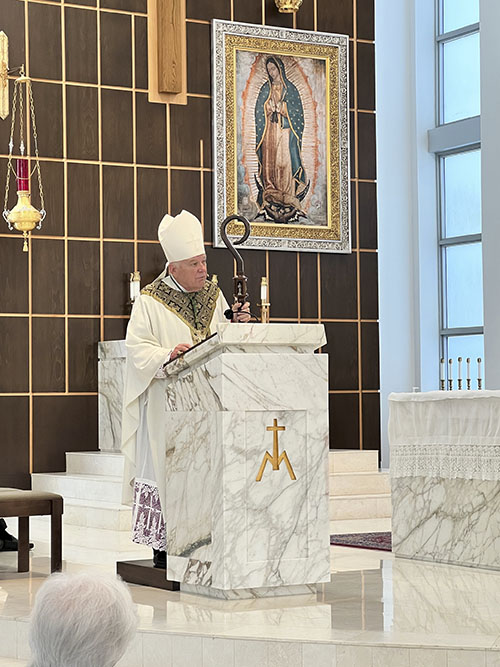By Archbishop Thomas Wenski - The Archdiocese of Miami
Archbishop Thomas Wenski preached this homily while celebrating a Mass on All Souls Day, Nov. 2, 2022, at Our Lady of Guadalupe Church in Doral, located next to Our Lady of Mercy Cemetery.
This Mass is offered for the repose of the souls of all those of your families who have gone home to the Lord – marked with the sign of faith. We pray for them, asking the Lord to bring them to the fullness of Eternal Life – and we pray for you that the Lord will comfort you in your grief.
Ofrecemos esta Misa por el eterno descanso de sus seres queridos y por la consolación de sus familias que siguen en esta peregrinación por este valle de lágrimas.
Como católicos vemos la muerte no como el fin de nuestras vidas sino más bien como una puerta que abre el camino para nosotros hacia la vida eterna. Sin embargo, morir no es fácil – por eso rezamos para obtener la gracia de morir bien: Jesús, José, María, les doy el corazón y el alma mía; Jesús, José, María, asístanme en mi última agonía; Jesús, José, María, reciban, cuando muera, el alma mía.

Photographer: MARIA A. RIVAS | FC
Archbishop Thomas Wenski preaches his homily on All Souls Day, Nov. 2, 2022, at Our Lady of Guadalupe Church in Doral.
For years, many ended their day by praying: “From a sudden and improvident death, deliver us, O Lord.”
Today’s Mass for All Souls follows yesterday’s solemnity of All Saints. These liturgical commemorations are for us, Catholics, a lesson in ecclesiology, or in how the Church understands herself. The Church, as the Second Vatican Council reminded us, is essentially a communion: through baptism we enter into the very life of God – the Father, Son and Holy Spirit. We become members of one body, the Body of Christ. This is what faith in God, the Father of Jesus, gives us – a family; God is our Father, Jesus our brother, and Mary, our mother.
That communion which is ours in Christ is called in the Apostles’ Creed: “the communion of saints.” This communion refers to the network of relationships that is rooted in the very life of God: Father, Son and Holy Spirit that draw us together into “one body, one Spirit in Christ.” And that expression is a wonderful way of answering the question, what is the Church? For what is the Church, but the assembly of all the saints, living and dead?
And that communion is only severed by serious sin. Death does not sever our communion with the saints – therefore, tradition has spoken of three states of the Church: the Church triumphant – those of our numbers who have already entered into the glory of everlasting life; the Church suffering – those of the faithful departed who will soon enter heaven but are now experiencing the final purgation or purification that we Catholics call purgatory; and the Church militant, that is those of us who while citizens of heaven through our baptism are still on our pilgrimage on earth, traversing as it were, alien land until we reach our true fatherland, the kingdom of heaven.
These feasts also help underscore for us what is one of the central teachings of the Second Vatican Council – a teaching that certainly is not something new or original to the Council but a teaching which the Council wished to give a renewed emphasis, namely the universal call to holiness that each Christian receives in baptism.

Photographer: MARIA A. RIVAS | FC
Archbishop Thomas Wenski exitsOur Lady of Guadalupe Church in Doral after celebrating the Mass for All Souls Day, Nov. 2, 2022.
El mes de noviembre, con sus fiestas de Todos los Santos y de Todos los Fieles Difuntos, debe reforzar en nosotros la esperanza cristiana. Y la creencia católica en el Purgatorio – esa purificación final de los elegidos – nos da motivo de quedarnos firmes en esta esperanza. Porque existe el purgatorio, no debemos desesperarnos de la salvación eterna de nuestros seres queridos que han muerto sin haber alcanzado esa santidad perfecta necesaria para poder entrar en la presencia de Dios
La fe en Jesucristo nos da una familia – somos hermanos de Cristo y su Padre es nuestro Padre, y su madre es nuestra madre. El corazón de Jesús es de verdad una hoguera del divino amor que esparce sus ardores en todas las direcciones: en el cielo en la Iglesia triunfante, en la tierra en la militante y en el purgatorio en la sufriente. Así, en el símbolo de la fe, o sea el Credo, afirmamos que creemos en la comunión de los santos – esa comunión es esa red de relaciones a la cual entramos por el bautismo en la vida misma de Dios: Padre, Hijo, y Espíritu Santo. Y esa comunión es más fuerte que la muerte – pues, como decimos en la Misa, “para quienes creemos en ti, Señor, la vida se transforma, no se acaba; y disuelta nuestra morada terrenal, se nos prepara una mansión eterna en el cielo.”
During November, when the days grow shorter, we do well to remember the shortness of our lives and meditate on those “Last Things” that await us all. But, thanks to the feasts of All Saints and All Souls, our November reflections do not have to be morose but rather should be hopeful.
Our belief in purgatory – the final purification of the elect – helps us Catholics to remain firm in that hope. Because there is a purgatory, we need not despair of our own or our loved ones’ personal salvation if when we die, we still fall short of the perfect holiness required to enter into God’s presence.
Dales Señor el descanso eterno; Brille para ellos la luz perpetua; Que descansen en paz. Amén.

